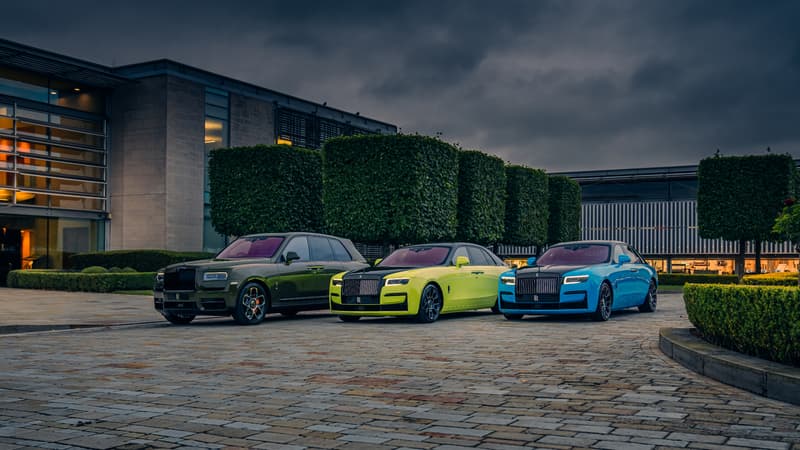But where will the luxury car brands stop? After good results in 2021 and then in the first half, the trend clearly continued in the third quarter.
Rolls-Royce towards a new sales record
Rolls-Royce, a symbol of maximum luxury with a catalog of models starting at 300,000 euros, has just delivered, for example, 1,510 vehicles between July and September. This is 181 more than in the third quarter of 2021 and enough to further improve its balance sheet since the beginning of the year. With 4,701 deliveries, the Goodwood brand is on track to break its record of 5,586 cars produced last year.
A drop in sales of its owner, the BMW group. Rolls-Royce sales represent 0.26% of the total production of 1.75 million units since the beginning of the year (1.53 million for BMW, 209,000 for Mini, its other British brand). But a not insignificant contribution to the results: although BMW does not give the details of the financial results by brand, the German group registered a turnover of 103 billion euros during the first three quarters, 24.5% more, and a net profit of 16,400 million euros, which jumped 60%.
At Volkswagen, luxury has a smile
The Volkswagen group has also just published its results. Among its most prestigious brands we find Porsche, which was particularly successful in its IPO and confirms its good financial health. The volume of sales has advanced little since the beginning of the year, up to 221,512 cars, 2% more, but the rise in prices is reflected in the turnover: 26,740 million euros in the first nine months, 15.7% more, and a gross operating margin of 5,050 million euros compared to 3,590 million last year.
The same good health at Audi, with a turnover of 44.6 billion euros in the first three quarters, for a profit of more than 6 billion, or an operating margin of 14%.
Lamborghini and Bentley (which are included in Audi’s results with the Ducati motorcycle brand) also saw their sales grow, respectively, by 7.6% (7,430 units) and 3.5% (11,316) with operating margins of 29 .6% and 23.1%.
“Lamborghini, Bentley and Ducati have contributed significantly to our strong financial performance. This shows once again that our group of brands is much more than the sum of its parts,” said Jürgen Rittersberger, member of the board of directors for finance and legal. affairs of Audi AG, quoted in a press release.
Mercedes remains cautious
Despite net profit doubling over a year in the third quarter of 2022, to €4bn, Mercedes-Benz remains fairly cautious, citing the “exceptional degree of uncertainty” surrounding macroeconomic and geopolitical conditions.
“Other effects due to the rapidly changing situation in Russia and Ukraine are unknown and have not yet been reflected in our key figures, but could have material negative consequences for our business activities,” the group warns in its press release.
The prospects of recovery in China could, however, offset the risks of recession in Europe in a context of “persistence of very high inflationary pressures for consumers and companies”.
A difficult context that does not prevent the German group from welcoming the good level of sales of luxury models and the doubling of deliveries of its electric models.
Ferrari, in top form before his SUV
Another great symbol of luxury and motorsports, Ferrari also displays iron health. During the first nine months of the year, the Maranello group obtained a net profit of 718 million euros, 16% more, and revenues of 3,720 million euros (+20%).
The order book well filled It even allows Ferrari to raise its billing forecasts for this year and up to 6,700 million euros for 2026.
The Italian brand relies in particular on its first recently presented SUV, the Purosangue. Enough to replicate the success of the Urus at Lamborghini or the Cullinan at Rolls-Royce.
The exception: Aston Martin is still in crisis
The only snag in this panorama of luxury brands: Aston Martin. Despite an increase in sales, the British brand saw its losses more than double in the third quarter, to 228 million pounds (260 million euros).
“Aston Martin has racked up disappointments since its unsuccessful London IPO in late 2018. Saved from bankruptcy in early 2020 by Canadian billionaire Lawrence Stroll, the company is now looking to evolve further into luxury and begin the shift towards luxury. ‘electrification’. ‘, summarizes the AFP.
“Aston Martin has fantastic cars and a strong brand, but its financial situation presents a real challenge,” says Third Bridge analyst Orwa Mohamad, referring in particular to a debt of more than 800 million pounds for the British brand.
Source: BFM TV


